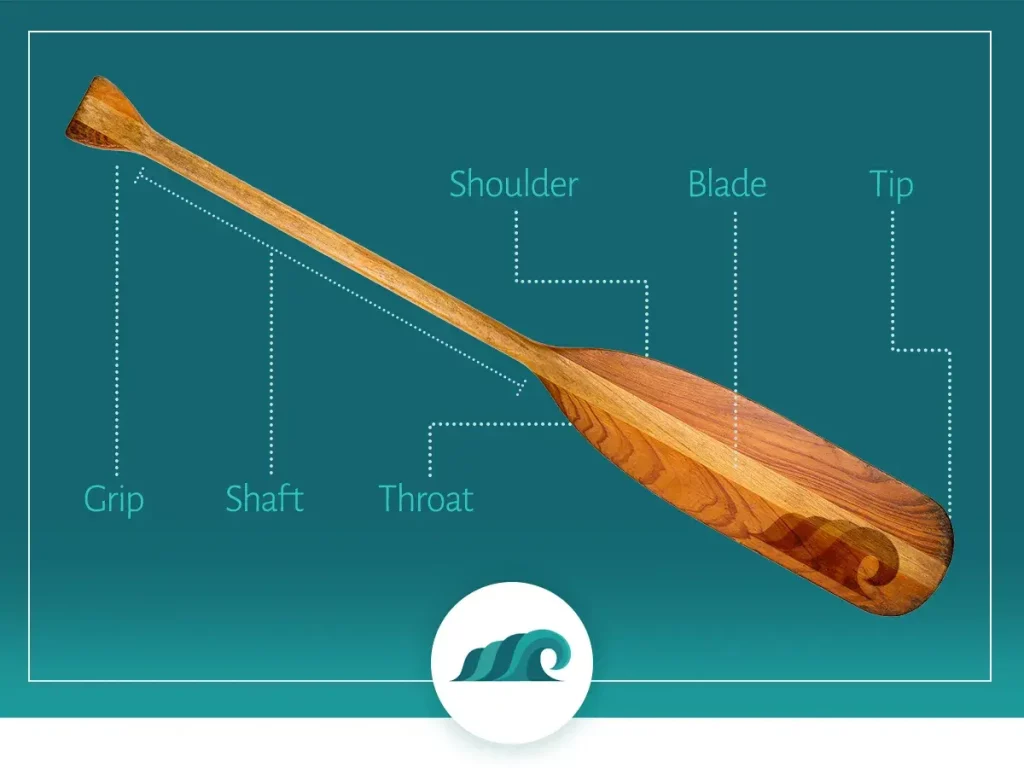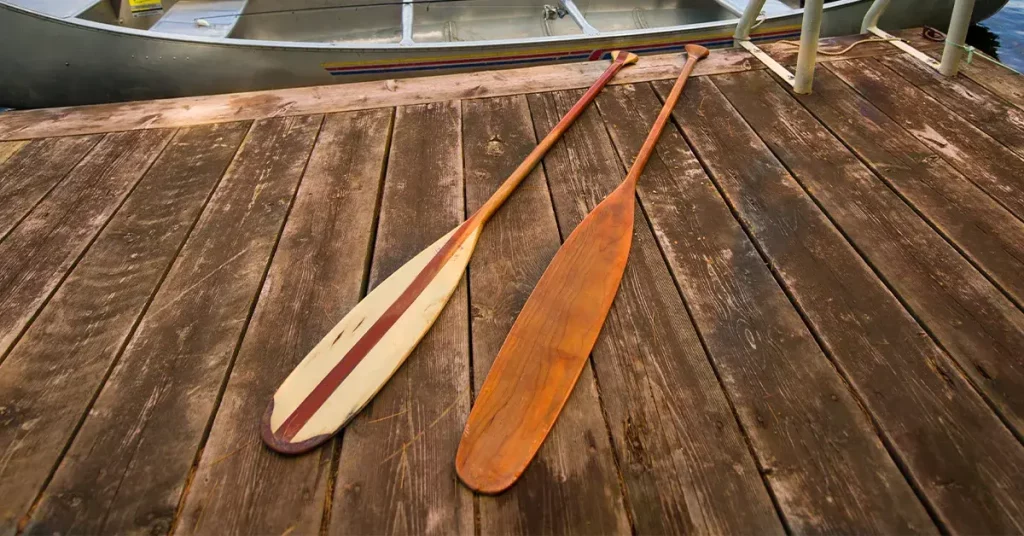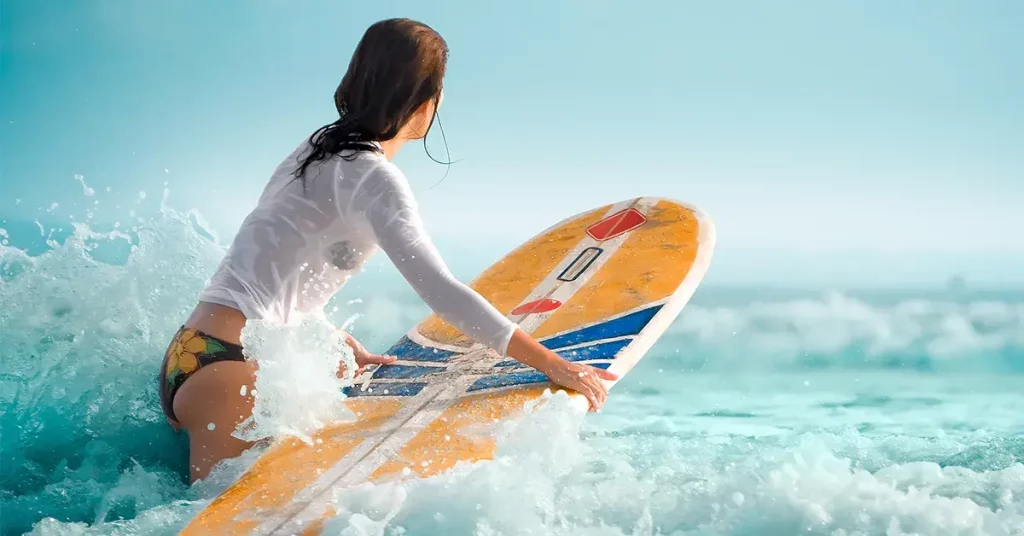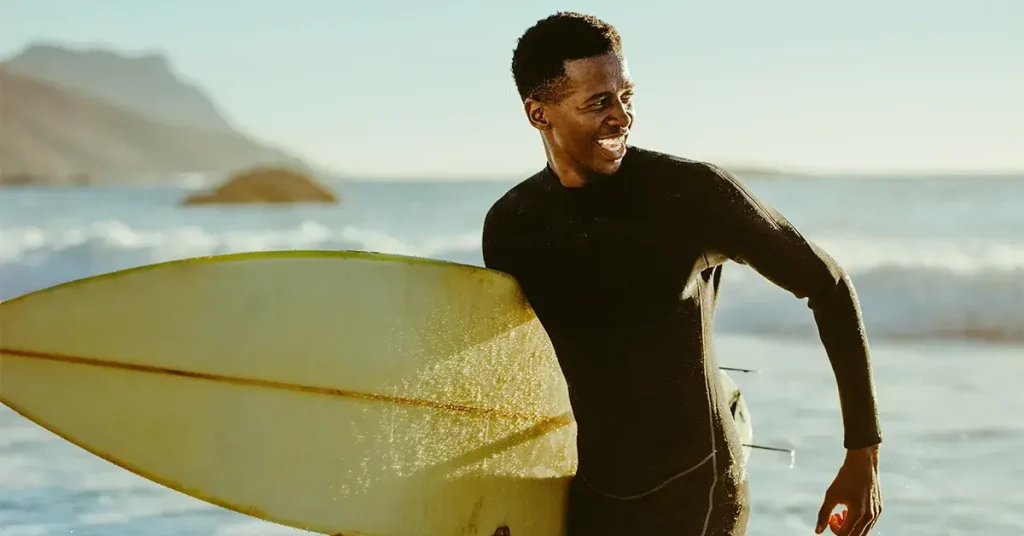Besides the canoe itself, your canoe paddle is without a doubt the most important piece of gear you’ll need for paddling. After all, it’s the engine that propels your entire craft through the water.
Without it – you may find yourself up a creek without a paddle – literally!
Knowing the terminology related to canoe paddles will also allow you to communicate effectively on the water.
If you’re new to canoeing, or just need a little refresher course, I’ll break down the different parts of a canoe paddle, some of the different options available, and how to select the right one for your needs and preferences.
Canoe Paddle Terms

Every paddler needs a good grasp of the different parts of a canoe paddle. Let’s get into them in more detail.
Starting from the grip and moving downwards, a canoe paddle has 6 main components:
- Grip: The grip is the uppermost part of the canoe paddle. It’s the part where your upper hand connects with the paddle during canoe strokes.
- Shaft: Below the grip, the shaft is the long thin portion of the paddle that runs the length of the paddle between the grip and blade.
- Throat: The throat is the portion of the paddle where the shaft begins to widen out and form the blade.
- Shoulder: Below the throat, the shoulder is the section of the canoe blade that flares out before straightening out.
- Blade: The blade refers to the entire flat portion that’s used to propel your craft through the water while paddling.
- Tip: The very bottom of the canoe paddle forms the paddle tip. This portion is used to push off of docks, beaches, and other objects, so it’s often reinforced to make it more durable than the rest of the blade.
Now that you’re familiar with the various parts of a canoe paddle, let’s take a look at some of the different options you’ll find on different paddles.
Grips
While it may not seem like it to the casual observer, the grip is actually one of the most important components of a canoe paddle.
Spend a few hours paddling intensely, and you’ll know exactly what I mean. A poorly fitting grip will make your stroke less efficient, and can even cause blisters and chafing on your hands.
The two main grip types you’ll find on canoe paddles: Palm Grips, and T-Grips.
There is also a hybrid style grip that combines some of the features of both grip types into one.
PALM GRIPS
Palm grips, like the name, suggests, form fit to the shape of your palm. These grips are comfortable for prolonged paddling sessions and offer a nice balance between comfort and control.
Under the umbrella of ‘palm grips,’ there are two main sub-types: Symmetrical and Asymmetrical grips.
SYMMETRICAL GRIPS
Symmetrical grips are the same shape on both sides of the grip. This means you can paddle with either side of the paddle equally well. This design is often found on straight shaft paddles and is often favored by many beginners due to its simplicity. Simply grab the grip any way you like and start paddling!
ASYMMETRICAL GRIPS (also known as directional palm grips)
Asymmetrical grips are one-direction grips that provide an extremely ergonomic grip ideal for long term paddling. This is the most comfortable grip type for most people and is often found on higher-end and bent shaft paddles.
T-GRIPS
T-grips provide the paddler with the highest level of control and leverage but are less comfortable for prolonged paddling than palm grips. These grips feature a T-shaped handle, which gives you the ability to pry and maneuver your canoe in adverse conditions.
Whitewater paddlers often favor this design, as it gives them a high level of control in fast-moving mater. Keep in mind that you will be sacrificing some comfort for control with a T-grip.
HYBRID PALM/T-GRIP
While it’s not the most common grip type, if you’re looking for a compromise between the control of a T-grip and the comfort of a palm grip, the hybrid grip may be for you.
This grip type can either be symmetrical or asymmetrical, depending on whether it’s paired with a straight or bent shaft.
Shaft
The shaft is the long thin portion that runs the length of the paddle between the grip and the throat. Your lower hand grips the shaft during a typical canoe paddle stroke.
Shafts can either be straight or bent.
- Straight shafts are the traditional canoe paddle style. They’re highly versatile and can be used for a variety of strokes and maneuvers. They work well in a wide variety of water conditions, including whitewater, flatwater, and everything in between.
- Bent shaft paddles are specifically designed for flatwater cruising. They’re a little more specialized, and offer increased power in the water while sacrificing some maneuverability. The angle of the blade is typically between 7° and 14° – with smaller angles offering less stroke efficiency but more variety of strokes.
The shaft can also be either round or oval-shaped. Oval shaped handles offer a more comfortable and ergonomic grip, especially for prolonged multi-day paddling.
Blade
After the shaft, throat, and shoulder, comes the real powerhouse of your canoe paddle – the blade. The blade shape and size determines the amount of resistance it creates in the water, which impacts how much power it can generate per stroke.
Blades come in a wide variety of shapes and sizes, with the main ones being Beavertail, Ottertail, teardrop, and square-tipped.
BEAVERTAIL AND OTTERTAIL BLADES
Like their names suggest, are long narrow blades modeled after the tails of their respective aquatic namesakes. Beavertails are wider towards the tip, and slim towards the shoulder – which makes them great for smooth paddling in deeper water. Ottertails are narrower towards the shoulder and the tip, making them ideal for deep water solo paddling as well as all-day paddling.
SQUARE-TIPPED PADDLES
These offer maximum power and propulsion in the water. They’re typically used in whitewater and river paddles and aren’t particularly efficient for all-day paddling. This shape is also found in cheaper recreation paddles as well.
TEARDROP-SHAPED PADDLES
These blades are a newer take on the classic beavertail shape. The blade is wider and shorter than a traditional beavertail, which makes it perfect for all-day shallow water paddling.
Canoe Paddle Tip
Last, but certainly not least, is the canoe paddle tip. This is the bottom-most portion of the blade and is the most vulnerable to damage from knocking into rocks, gravel, and other underwater obstacles.
Many wood paddle manufacturers’ reinforce the tip with a fiberglass or lacquer coating, which protects it from accidental damage. If you’re looking for a shallow-water paddle, this is an important feature to consider.
Plastic and composite blades are intrinsically durable, which means their tips can withstand the wear and tear of pushing off rocks and other obstacles.




